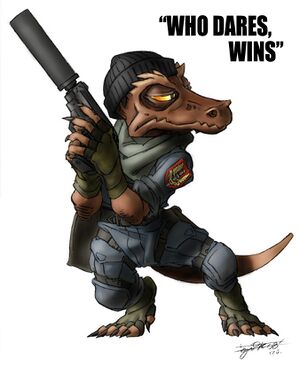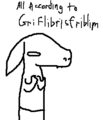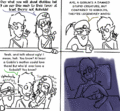Kobold

Kobolds are a race of creatures from the Dungeons & Dragons series of games. They've undergone a great deal of remodelling over the editions, going from big-eyed goblin-kin in OD&D to horned ratmen/dogmen in AD&D to their final iteration in 3rd edition, where they became puny reptilian creatures that were possibly related in some way to dragons. In either case, they are small, weak creatures, generally serving in most campaigns as low-level cannon fodder for the adventurers to mow down, much like goblins and orcs.
Despite being physically weak, however, kobolds are also described as capable trapsmiths, and are known for creating traps to protect their lairs and dungeons (a habit that is usually ignored or underplayed by most DMs). This habit - combined with a penchant for lethal tunnel design and group tactics - were famously used in the tale of Tucker's Kobolds to illustrate that kobolds - and, indeed, any intelligent creature - can remain dangerous to high-level adventurers despite being statistically inferior in just about every way.
If played with the intention of being dangerous, kobolds are far and away the hardest throwaway monsters to fight. It could be likened to a sort of sick, hardcore version of Home Alone, with the kobolds taking the part of a severely deranged and sadistic Kevin McCallister and the PCs taking the part of hopelessly underprepared thugs walking into a situation they cannot have possibly foreseen. If treated like cannon fodder, they are the absolute hands-down easiest things in any edition to kill, including housecats and electric iguanas.
Kobolds are often used as "weakling" monsters in games, particularly video games based on the pen-and-paper variety. Their actual versatility depends on the system, but like D&D runs the gamut of harmless to devastating in numbers to downright impossible. While modern D&D paints them as reptilian creatures, some other games and media portray them as either wolf/dog-like (such as Dwarf Fortress) or rat-like (Warcraft).
There is a market in 3.5 for kobold PCs, since their draconian/reptilian ancestry make them one of the only +0 Level Adjustment races capable of qualifying for much of the additional material in splatbooks like the Draconomicon and the Book of Dragons. Pun-Pun, for example, is a rather famous CharOp design that allows a kobold wizard to attain theoretically unlimited abilities and attributes, using material from splatbooks and the Forgotten Realms campaign setting.
While 4e technically does allow for 0LA characters using the "racial features" rules in the Monster Manual, they effectively play like reptilian halflings, which get better bonuses. The lack of splat and reptilian-based bonuses makes them less appealing than 3e, but their inherent trap skills make them excellent rogues.
D&D Stats
Kobolds have long been one of the playable monstrous races of Dungeons & Dragons, although their precise mechanical crunch has been... kind of hit and miss. Pathfinder and 5th edition's versions in particular have often been angrily derided for actually being weaker than Goblins, who are supposed to be on roughly the same level of inferiority on the totem pole.
AD&D/2nd Edition
From the Complete Book of Humanoids.
- Ability Score Modifiers: -1 Strength, -1 Constitution
- Altered Ability Scores: Minimum Dexterity and Constitution of 4, Maximum Strength of 15, Maximum Constitution of 16, Maximum Intelligence of 17, Maximum Charisma of 14
- Class & Level Restrictions: Fighter (8), Cleric (9), Shaman (7), Witch Doctor (7), Thief (12)
- Size: Small
- Special Advantages: Infravision 60 feet, Intelligent or Powerful creatures will attack a kobold last unless it is obviously a threat
- Special Disadvantages: Light Aversion (-1 penalty to attack rolls in equivalent of direct sunlight), gnomes receive a +1 to attack rolls against kobolds
- Weapon Proficiencies:
- Non-Weapon Proficiencies:
3rd Edition
From Races of the Dragon.
- Ability Score Modifiers: +2 Dexterity, -4 Strength, -2 Constitution
- Size: Small
- Type: Humanoid (Dragonblood, Reptilian)
- Speed: 30 feet
- Darkvision 60 feet
- +1 Natural Armor Class Bonus
- Trapmaking is always considered a Class Skill
- +2 racial bonus to Craft (Trapmaking), Profession (Miner) and Search checks
- Light Sensitivity: Dazzled when exposed to bright sunlight or a daylight spell
- Favored Class: Sorcerer
Pathfinder
In addition to appearing in the Advanced Race Guide and Inner Sea Races, Kobolds got their own mini-booklet specifically aimed at Kobolds of Golarion, with a bunch of new traits - including special "bonus" traits based on what color their scales were.
- Ability Score Modifiers: +2 Dexterity, -4 Strength, -2 Constitution
- Size: Small
- Type: Humanoid (Reptilian)
- Speed: 30 feet
- Darkvision 60 feet
- Armor: +1 natural armor
- Crafty: +2 racial bonus to Craft (Traps), Perception, and Profession (Miner), Craft (Traps) and Stealth are always Class Skills
- Weakness: Light Sensitivity
Alternate Racial Traits:
- Beast Bond: Replace Crafty with +2 racial bonus to Handle Animal and Ride checks, with Handle Animal and Ride always being Class Skills.
- Dragon-Scaled: Replace Armor with Resistance 5 to either Acid, Cold, Electricity or Fire Damage.
- Gliding Wings: Replace Crafty with the ability to Glide; when falling, a kobold can make a DC 15 Fly check to land without injury as if using the Feather Fall spell, and if it succeeds on this check, can then make a second DC 15 Fly check to move 5 feet laterally for every 20 feet fallen.
- Jester: Replace Crafty with +2 racial bonus to Diplomacy and Perform checks, with Diplomacy and Perform always being Class Skills.
- Dayrider: Downgrades a kobold's Darkvision to Low-Light Vision, but removes its Light Sensitivity.
- Dragonmaw: Replaces Armor with a D4 damage bite attack that can also deal a bonus +1d6 fire/acid/cold/lightning damage (chosen and set at character creation) 1/day.
- Echo Whistler: Replaces Crafty with the ability to try and make a Bluff check with just a bit of vocal mimicry 3/day, gaining a +2 bonus to the check in any place that would generate an echo.
- Frightener: Replaces Armor with a +1 DC boost to any Fear spell that the kobold casts.
- Prehensile Tail: Replaces Armor with a +2 bonus to Acrobatics & Climb checks and the ability to draw a hidden weapon as a move action.
- Secret Strider: Replaces Crafty with the ability to, twice per day, enter a super-sneaky mode for 1 minute. During this time, the kobold leaves no trail when moving through natural surroundings, increasing the DC of Survival checks to track it by +10.
- Shoulder To Shoulder: Replaces Crafty with a +1 bonus to Aid Another checks, the ability to occupy the same space as another Small creature without penalty, and the ability to gain a +1 AC bonus when sharing a space with another kobold with this trait.
- Spellcaster Sneak: Replaces Crafty with a +2 bonus to Stealth checks. A kobold spellcaster with this trait can also freely apply Silent Spell to a spell 1/day.
- Wild Forest Kobold: Replaces Crafty with a +2 bonus to Perception and Survival checks. Additionally, Stealth and Survival are always class skills for this kobold.
- Wyrmcrowned: Replaces Crafty with a +2 bonus to either Diplomacy or Intimidate and the ability to count the chosen skill as always being a class skill.
4th Edition
In this edition, kobolds received their first writeup in the Monster Manual 1.
- Ability Score Modifier: +2 Dexterity +2 Constitution,
- Size: Small
- Vision: Normal
- Speed: 6 squares
- Skill Bonus: +2 Stealth, +2 Thievery
- Trap Sense: +2 to all defenses against traps
- Racial Power - Shifty: At-Will power. You can spend a minor action to Shift 1 square
They later got beefed up in the Dungeon Survival Guide. This gave them the Reptile type and replaced Shifty with Shifty Manuever, an Encounter power that lets the kobold and all allies within Close Burst 2 shift 1 square as a free action.
It also gave them five new racial utility powers; Flee! (level 2 Daily; kobold and all allies in Close Burst 2 get +2 to all defenses for 1 turn and shift their full speed), Load Slingpot (level 2 Encounter; kobold with a sling can fling a randomly enchanted projectile that will either give the target a turn-long attack penalty, set the target on fire, or immobilize them for a turn), Tunnel Scuttle (level 6 Encounter; free move action that can go up walls and through tight spaces without issue), Frantic Shift (level 10 Encounter; shift 1 square as a minor action, recharges if you get Bloodied) and Trap-Gang Method (level 10 At-Will; if you take trap/hazard damage with a non-minion creature adjacent to you, you can shift over half the damage you take to that creature).
5th Edition
From Volo's Guide to Monsters.
- Ability Score Modifier: +2 Dexterity, -2 Strength
- Size: Small
- Speed: 30 feet
- Darkvision
- Grovel: Once per encounter, can use an action on your turn to beg, plead, snivel and otherwise humiliate yourself; until the end of your next turn, all of your allies gain Advantage on attack rolls made against enemies within 10 feet of you and who can see your pathetic display.
- Pack Tactics: If at least one non-incapacitated ally is within 5 feet of a creature you are attacking, you gain Advantage on attack rolls against that creature.
- Sunlight Sensitivity: You suffer Disadvantage on attack rolls and Wisdom (Perception) checks made when you or your target are in direct sunlight.
Real life Kobold
Those of us who took high school chemistry will remember element 27 on the periodic table is named "cobalt," which sounds similar to kobold. In fact, cobalt ore was named by German miners after the stories of these malevolent underground spirits. The ore is naturally found as sharp shards, bonded with arsenic oxide. The shards are sharp enough to penetrate boots and feet, hurting miners and making them sick just as if they were poisoned caltrop traps left by kobolds.
A "cobalt bomb" is a proposed nuclear weapon designed to poison a large territory with super-radioactive cobalt dust, making the target area uninhabitable for 105 years. The short half-life makes it especially deadly, but possible for your great-grandchildren to recover the empty territory. So watch out for "kobold bombs" on "magic missiles".
Cutebolds
Cutebolds are like Kobolds only incredibly cute.
They are pitiful and childish in everything they do, and are innocent enough to not know how to procreate. All they know is that rubbing their noses gives them a guilty pleasure. They are no less "harmless" when played properly, though. They tend toward the dog-like for extra D'aww.
This interpretation of the Kobold is thought to have been inspired by their depiction in Dwarf Fortress, where they steal your supplies, but seem to do it in the most endearingly stupid manner possible.
Cutebold stats:
- +2 Dex, +2 Cha, -2 Int
- Charm person once per day as a spell like ability
- Low light vision and scent
-
There's no word in kobold for "keikaku"
-
Kobold Camp now with 3D rendering
-
Love can bloom under a battlefield
-
Aw, they think they're people!
-
Someone's got a widdle crush!
See also
| Dungeons & Dragons 4th Edition Races | |
|---|---|
| Player's Handbook 1 | Dragonborn • Dwarf • Eladrin • Elf • Half-Elf • Halfling • Human • Tiefling |
| Player's Handbook 2 | Deva • Gnome • Goliath • Half-Orc • Shifter |
| Player's Handbook 3 | Githzerai • Minotaur • Shardmind • Wilden |
| Monster Manual 1: | Bugbear • Doppelganger • Githyanki • Goblin • Hobgoblin • Kobold • Orc |
| Monster Manual 2 | Bullywug • Duergar • Kenku |
| Dragon Magazine | Gnoll • Shadar-kai |
| Heroes of Shadow | Revenant • Shade • Vryloka |
| Heroes of the Feywild | Hamadryad • Pixie • Satyr |
| Eberron's Player's Guide | Changeling • Kalashtar • Warforged |
| The Manual of the Planes | Bladeling |
| Dark Sun Campaign Setting | Mul • Thri-kreen |
| Forgotten Realms Player's Guide | Drow • Genasi |





